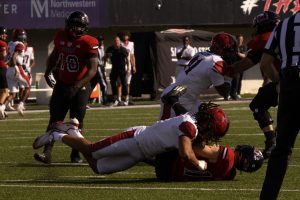College continues to use aluminum bats, despite possible dangers
May 1, 2008
He lay motionless.
His head quickly swelled like a balloon. The hearts of all Huskie players and fans dipped at one moment.
NIU pitcher Mark Badgley had been struck in the temple by a sizzling line drive off the bat of Bradley’s Mark Santoro. Badgley escaped with his health intact, but his injury is just one of many.
Horrific injuries, like that suffered by Badgley in April 2005, have been prevalent throughout college baseball, and many place the blame on aluminium bats.
Despite the injuries, colleges continue to use aluminum bats. Some believe the reason is economics.
NIU head baseball coach Ed Mathey believes inexperience with wood bats would make broken bats more prevalent at the college level than the professional, which could also potentially impact clubs from a financial level by having to continue purchasing new bats.
“College players are less experienced swinging a wooden bat,” Mathey said. “At this level, we would have a lot more broken bats.”
NIU designated hitter Justin Behm echoes Mathey’s sentiments on swinging a wood bat.
“College players don’t know how to swing wooden bats properly,” Behm said. “Colleges don’t have enough funding for wood bats.”
Beside funding, the quality of the wood comes into question.
Ty Halpin, liaison to the NCAA Baseball Rules Committee, questions the quality of the wood used for bats.
“There are different wood qualities that may cause the bat to break or crack,” Halpin said.
For NIU, paying to replace broken bats would mean spending money that could go into other aspects of the program.
The actual amount of money wood bats cost isn’t the only economical reason college baseball teams are opting to stick with aluminium bats.
Since some Division I schools either have reduced rates on their aluminum bats or get them completely free, the switch to wood would cost the program money, Mathey said.
The Huskie skipper also said Division I programs don’t vote for a switch to wood bats because losing the contracts from aluminum bat-producing companies would hurt programs.
One example of many is the University of Kansas, which is sponsored by sporting goods manufacturer Easton. If the NCAA switched to wood bats, the Jayhawks would have to find alternative means to pay for the lumber.
Former Cook County Cheetahs pitching coach and current high school baseball coach Doug Wellenreiter agrees with Mathey.
“Contracts are a big part of the reason colleges won’t switch,” Wellenreiter said. “The money allows programs to improve in other ways.”
Many baseball companies give away their bats and other products to Division I baseball programs as a way to market their name and product. The contracts given by companies save Division I programs thousands of dollars.
“Aluminum bats are somewhere around $290,” Mathey said. “If a team gets 20 bats a year, that’s right around $6,000.”
NIU has a contract with Rawlings Sports, which helps to cover the cost of bats, Mathey said. The Huskies also receive special prices on Louisville Slugger bats.
With sponsorships provided, Mathey believes most college programs are not going to vote for something that will give them less money.
“Some of the companies give their bats to certain schools,” Mathey said. “A coach is not going to vote for a change to wood bats if it’s going to hurt their program.”






